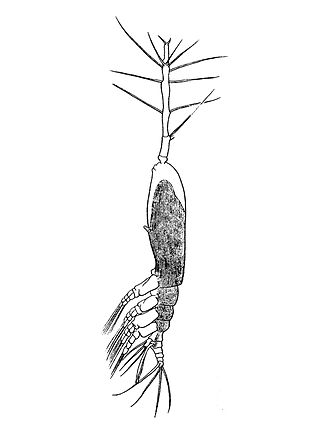Related Research Articles

Herring are forage fish, mostly belonging to the family of Clupeidae.

Zooplankton are the animal component of the planktonic community. Plankton are aquatic organisms that are unable to swim effectively against currents. Consequently, they drift or are carried along by currents in the ocean, or by currents in seas, lakes or rivers.

Copepods are a group of small crustaceans found in nearly every freshwater and saltwater habitat. Some species are planktonic, some are benthic, a number of species have parasitic phases, and some continental species may live in limnoterrestrial habitats and other wet terrestrial places, such as swamps, under leaf fall in wet forests, bogs, springs, ephemeral ponds, puddles, damp moss, or water-filled recesses of plants (phytotelmata) such as bromeliads and pitcher plants. Many live underground in marine and freshwater caves, sinkholes, or stream beds. Copepods are sometimes used as biodiversity indicators.

Holoplankton are organisms that are planktic for their entire life cycle. Holoplankton can be contrasted with meroplankton, which are planktic organisms that spend part of their life cycle in the benthic zone. Examples of holoplankton include some diatoms, radiolarians, some dinoflagellates, foraminifera, amphipods, krill, copepods, and salps, as well as some gastropod mollusk species. Holoplankton dwell in the pelagic zone as opposed to the benthic zone. Holoplankton include both phytoplankton and zooplankton and vary in size. The most common plankton are protists.

Harpacticoida is an order of copepods, in the subphylum Crustacea. This order comprises 463 genera and about 3,000 species; its members are benthic copepods found throughout the world in the marine environment and in fresh water. A few of them are planktonic or live in association with other organisms. Harpacticoida represents the second-largest meiofaunal group in marine sediments, after nematodes. In Arctic and Antarctic seas, Harpacticoida are common inhabitants of sea ice. The name Harpacticoida comes from the Greek noun harpacticon and the suffix -oid and means reminiscent of a predator.

Siphonostomatoida is an order of copepods, containing around 75% of all the copepods that parasitise fishes. Their success has been linked to their possession of siphon-like mandibles and of a "frontal filament" to aid attachment to their hosts. Most are marine, but a few live in fresh water. There are 40 recognised families:

Calanoida is an order of copepods, a group of arthropods commonly found as zooplankton. The order includes around 46 families with about 1800 species of both marine and freshwater copepods between them.

The Cyclopoida are an order of small crustaceans from the subclass Copepoda. Like many other copepods, members of Cyclopoida are small, planktonic animals living both in the sea and in freshwater habitats. They are capable of rapid movement. Their larval development is metamorphic, and the embryos are carried in paired or single sacs attached to first abdominal somite.

Poecilostomatoida is a suborder of copepods. Although it was previously considered a separate order, recent research showed it to be nested within the Cyclopoida.

Monstrilloida is an order of copepods with a cosmopolitan distribution in the world's oceans. The order contains a single family, Monstrillidae. The name of the first ever described genus Monstrilla is derived from latin, meaning "tiny monster", because the lack of usual diagnostic features of copepods puzzled early taxonomists.

The San Francisco Estuary together with the Sacramento–San Joaquin River Delta represents a highly altered ecosystem. The region has been heavily re-engineered to accommodate the needs of water delivery, shipping, agriculture, and most recently, suburban development. These needs have wrought direct changes in the movement of water and the nature of the landscape, and indirect changes from the introduction of non-native species. New species have altered the architecture of the food web as surely as levees have altered the landscape of islands and channels that form the complex system known as the Delta.

George Stewardson Brady was a professor of natural history at the Hancock Museum in Newcastle-upon-Tyne who did important volumes on Copepoda and Ostracoda, including those from the Challenger expedition.

Forage fish, also called prey fish or bait fish, are small pelagic fish which are preyed on by larger predators for food. Predators include other larger fish, seabirds and marine mammals. Typical ocean forage fish feed near the base of the food chain on plankton, often by filter feeding. They include particularly fishes of the order Clupeiformes, but also other small fish, including halfbeaks, silversides, smelt such as capelin and goldband fusiliers.
Syndinium is a cosmopolitan genus of parasitic dinoflagellates that infest and kill marine planktonic species of copepods and radiolarians. Syndinium belongs to order Syndiniales, a candidate for the uncultured group I and II marine alveolates. The lifecycle of Syndinium is not well understood beyond the parasitic and zoospore stages.
Centropagidae is a family of copepods in the order Calanoida. Its members are particularly known as plankton in coastal waters and in fresh water in Australia and southern South America. They are also found on subantarctic islands and in lakes in Antarctica.

Platycopiidae is a family of copepods. Until the description of Nanocopia in 1988, it contained the single genus Platycopia. It now contains four genera, three of which are monotypic; the exception is Platycopia, with 8 species.
Ellobiopsis is a genus of unicellular, ectoparasitic eukaryotes causing disease in crustaceans. This genus is widespread and has been found infecting copepods from both marine and freshwater ecosystems. parasitism has been seen to interfere with fertility in both sexes of copepods.

Trachurus lathami is a species of fish in the family Carangidae and the genus Trachurus, the jack mackerels. Common names include rough scad and horse mackerel in English, as well as chinchard frappeur (French), chicharro garretón (Spanish), jurel, and carapau, garaçuma, surel, and xixarro. It is native to parts of the western Atlantic Ocean, including seas off the eastern coasts of North and South America and the Gulf of Mexico.
Centropages is a genus of copepods in the family Centropagidae with 34 known marine species.

The clade Multicrustacea constitutes the largest superclass of crustaceans, containing approximately four-fifths of all described crustacean species, including crabs, lobsters, crayfish, shrimp, krill, prawns, woodlice, barnacles, copepods, amphipods, mantis shrimp and others. The largest branch of multicrustacea is the class Malacostraca.
References
- ↑ XXVII.—The subfamilies, genera, and species of the copepod family Ascomyzontidæ, Thorell: Diagnosis, synonymy, and distribution. W Giesbrecht, Journal of Natural History, 1895, Series 6, Volume 16, Issue 92, pages 173-186, doi:10.1080/00222939508680251